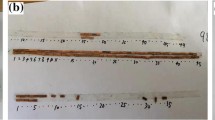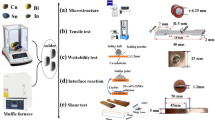Abstract
To study the high-speed shear properties of low-temperature solders, we select four groups of samples of Sn–xBi (x = 22, 30 wt%) and Sn−xIn alloys (x = 18, 22 wt%) with the melting temperature ranging from 190 to 200 °C. High-speed shear test results show that the shear strength of Sn–Bi/Cu solder joints is much higher compared to Sn−In/Cu solder joints, but their displacement is much lower. Consequently, the shear energy of Sn–Bi solders is less than half of the shear energy of Sn−In solders. This variation can be attributed to various fracture modes controlled by alloying element’s characteristics. Sn−xBi/Cu solder joints containing β-Sn, intrinsic brittle Bi phase and Cu6Sn5 exhibit brittle interfacial fracture, while Sn−xIn/Cu solder joints containing single γ-InSn4 phase and Cu6(Sn, In)5 show ductile fracture (e.g., Sn−22In/Cu) and part of mixed fracture (e.g., Sn−18In/Cu). This reveals that toughness of soft γ-InSn4 phase is much better than that of microstructure containing β-Sn and intrinsic brittle Bi phases. Furthermore, for Sn–Bi solders, the quantity of brittle Bi-rich phase in the fracture surface is proportional to Bi content in alloys, leading to lower strength of Sn−30Bi/Cu solder joints. While for Sn−In solders, compared to 18In/Cu, 22In/Cu solder joints contain more Cu6(Sn, In)5 IMCs in the matrix and thicker interfacial IMCs, it still exhibits higher shear energy under high-speed shear tests. This may be attributed to the fact that increasing In content not only makes the matrix softer but also coordinates with the deformation of interfacial IMC. The study provides a guidance for the development of low-temperature solder alloys with superior toughness.











Similar content being viewed by others
Data availability
The data that support the findings of this study are available from the corresponding author upon reasonable request.
References
S. Cheng, C.-M. Huang, M. Pecht, Microelectron. Reliab. 75, 77 (2017)
T. Tekin, IEEE J. Sel. Top. Quantum Electron. 17, 704 (2011)
G. Zeng, S.D. McDonald, Q. Gu, Y. Terada, K. Uesugi, H. Yasuda, K. Nogita, Acta Mater. 83, 357 (2015)
A.A. El-Daly, H. El-Hosainy, T.A. Elmosalami, W.M. Desoky, J. Alloys Compd. 653, 402 (2015)
H. Fu, J. Radhakrishnan, M. Ribas, R. Aspandiar, K. Byrd, J. Chen, S. Cheng, Q. Chen, R. Coyle, S. Feng, M. Krmpotich, S. Mokler, B. Sandy-Smith, K.K. Tang, G. Wu, A. Zhang, W. Zhen, 2018 Int. Conf. Electron. Packag. IMAPS Asia Conf. ICEP-IAAC (IEEE, Japan, 2018), pp. 13–18. Mie
N. Jiang, L. Zhang, L.-L. Gao, X.-G. Song, P. He, J. Mater. Sci. Mater. Electron. 32, 22731 (2021)
Z. Wang, Q.K. Zhang, Y.X. Chen, Z.L. Song, J. Mater. Sci. Mater. Electron. 30, 18524 (2019)
A. Sharif, Y.C. Chan, J. Alloys Compd. 390, 67 (2005)
J.R. Da Silva Leal, R.A.V. Reyes, G.L. De Gouveia, F.G. Coury, J.E. Spinelli, J. Electron. Mater. 52, 2957 (2023)
S. Cai, X. Luo, J. Peng, Z. Yu, H. Zhou, N. Liu, X. Wang, Adv. Compos. Hybrid. Mater. 4, 379 (2021)
C. Liu, X. Luo, J. Peng, Z. Yu, X. Wang, Electron. Compon. Mater. 7, 41 (2022). https://doi.org/10.14106/j.cnki.1001-2028.2022.0019
X. Luo, J. Peng, W. Zhang, S. Wang, S. Cai, X. Wang, Mater. Sci. Eng. A 860, 144284 (2022)
F. Wang, H. Chen, Y. Huang, L. Liu, Z. Zhang, J. Mater. Sci. Mater. Electron. 30, 3222 (2019)
W. Qin, J. Li, Q. Zhang, S. Jiang, J. Feng, W. Yang, Y. Zhan, J. Mater. Sci. Mater. Electron. 33, 177 (2022)
H.N. Fowler, A. Loaiza, D.F. Bahr, J.E. Blendell, C.A. Handwerker, J. Electron. Mater. 52, 7365 (2023)
L. Shen, P. Septiwerdani, Z. Chen, Mater. Sci. Eng. A 558, 253 (2012)
A. Luktuke, A.S.S. Singaravelu, A. Mannodi-Kanakkithodi, N. Chawla, Acta Mater. 249, 118853 (2023)
K. Lee, K.-S. Kim, K. Suganuma, J. Mater. Res. 26, 2624 (2011)
K.-O. Lee, J.W. Morris, F. Hua, J. Electron. Mater. 41, 336 (2012)
T. You, Y. Kim, J. Kim, J. Lee, B. Jung, J. Moon, H. Choe, J. Electron. Mater. 38, 410 (2009)
L. Shen, P. Lu, S. Wang, Z. Chen, J. Alloys Compd. 574, 98 (2013)
X. Chen, J. Zhou, F. Xue, Y. Yao, Mater. Sci. Eng. A 662, 251 (2016)
H. Okamoto, In-Sn (Indium-Tin), Binary Alloy Phase Diagrams, 2nd EditionASM International, (1990), pp. 2295–2296
T. El-ASHRAM, J. Mater. Sci. Mater. Electron. 16, 501 (2005)
M. Kamal, T. El-Ashram, Mater. Sci. Eng. A 456, 1 (2007)
S. Su, S. Hamasha, K. Hamasha, IEEE Trans. Compon. Packag Manuf. Technol. 9, 147 (2019)
H. Tsukamoto, T. Nishimura, S. Suenaga, K. Nogita, Mater. Sci. Eng. B 171, 162 (2010)
S. Tian, S. Li, J. Zhou, F. Xue, J. Alloys Compd. 742, 835 (2018)
Y. Du, Y. Qiao, X. Ren, Y. Lai, N. Zhao, Electronics. 12, 1899 (2023)
F. Tian, C.-F. Li, M. Zhou, Z.-Q. Liu, J. Alloys Compd. 740, 500 (2018)
Y. Zuo, C. Zhao, A. Robador, M. Wickham, S.H. Mannan, Acta Mater. 236, 118135 (2022)
L. Yang, L. Zhu, Y. Zhang, S. Zhou, G. Wang, S. Shen, X. Shi, Mater. Charact. 148, 280 (2019)
X. Li, F. Li, F. Guo, Y. Shi, J. Electron. Mater. 40, 51 (2011)
C.Y. Tan, M.A.A.M. Salleh, X.F. Tan, H. Yasuda, N. Saud, M.I.I. Ramli, K. Nogita, Mater. Today Commun. 31, 103221 (2022)
Acknowledgements
The authors would like to express our gratitude to all those who helped us during the experiment and writing of this thesis. We thank Qin Li and Mingfang Ba from Yunnan Tin Material Company Limited for helping to do the DSC and SEM test experiments. We also acknowledge the help of Jiaqi Yan from Jiangsu University of Science and Technology in the low-speed shear test of solder joint.
Funding
The authors gratefully acknowledge the supports from The Yunnan Fundamental Research Projects (Grant No. 202301BC070001-001) funded by the Yunnan Provincial Department of Science and Technology and Yunnan Tin Group (Holding) Co. Ltd.
Author information
Authors and Affiliations
Contributions
QW: Experiment, original draft, data processing and analysis, and Writing—original draft. SC: Original draft, data processing, and Writing—review. SY: SEM characterization. YY: Writing—review and discussion. YW: Writing—review and discussion. JP: Writing—review and discussion. JW: Experiment, Writing—review & editing, and discussion. XW: Conception, Writing—review & editing, and discussion.
Corresponding authors
Ethics declarations
Conflict of interest
The authors declare that they have no known competing financial interests or personal relationships that could have appeared to influence the work reported in this paper.
Ethical approval
Experiments in this paper do not involve in any vivo testing on animal subjects, human subjects, or human tissue.
Additional information
Publisher’s Note
Springer Nature remains neutral with regard to jurisdictional claims in published maps and institutional affiliations.
Rights and permissions
Springer Nature or its licensor (e.g. a society or other partner) holds exclusive rights to this article under a publishing agreement with the author(s) or other rightsholder(s); author self-archiving of the accepted manuscript version of this article is solely governed by the terms of such publishing agreement and applicable law.
About this article
Cite this article
Wang, Q., Cai, S., Yang, S. et al. Comparison of high-speed shear properties of low-temperature Sn-Bi/Cu and Sn-In/Cu solder joints. J Mater Sci: Mater Electron 35, 576 (2024). https://doi.org/10.1007/s10854-024-12302-3
Received:
Accepted:
Published:
DOI: https://doi.org/10.1007/s10854-024-12302-3




